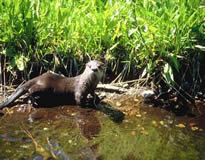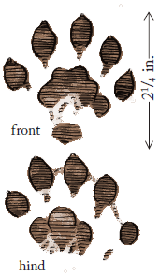Wildlife - Species

Species Specific Regulations
River Otter
Licenses: Hunting License required.
Limits: Weapon restrictions according to game zones please check for Limitations.

River Otter tracks
River Otter (Lutra canadensis)
Description
The otter is the largest member of the weasel family (Mustelidae) found in South Carolina. The otter has a long cylindrical body with a powerful tail, making it ideal for life in the water. Adult otters measure 35 to 55 inches in length, about one-third of which is tail. As with other mustelids, the otter has short, stout legs and stands low to the ground, measuring 7 to 9 inches at the shoulder. The fur is short and very dense. Overall coloration is dark brown, though its underside may be a pale or grayish brown.
Average Size
Males weigh about 15 to 20 pounds, with females slightly smaller.
Life Expectancy
The oldest recorded otter from South Carolina was 12 years old.
Preferred Habitat
Otters are always associated with water, preferring clear water relatively free of human disturbance. In South Carolina, otters are found in each of our major river drainages but are most abundant in the coastal marshes and blackwater swamps because of the abundance of food and cover. Another ideal habitat for otters in the low country is found in coastal waterfowl impoundments. In the Piedmont region, otters make good use of beaver ponds, often using abandoned beaver lodges as den sites. The shallow ponds created by beavers usually support an abundance of food items for otters.
Range
Otters historically existed throughout North America. Today their range is reduced, and the otter is absent or rare in several Midwestern and Northern states. Despite its nationwide decline, the otter appears to be doing quite well in South Carolina and throughout the Southeast. Otter populations are well established in every county in South Carolina and support a controlled harvest.
Food Habits
Otter are known to eat almost any animal matter found in aquatic systems including crayfish, crabs, mollusks, fish, turtles, and waterfowl. They are opportunistic, and their diet generally reflects the availability of the prey. Fish make up the largest portion of their diet. When fishing, otters usually prey on the slower fish such as carp, suckers, and catfish. Crayfish and crabs are important seasonal foods for otters.
Reproduction
Peak Breeding Activity Otters are monogamous and do not reach sexual maturity until age two. Most breeding occurs in later winter and early spring.
The young are born in late winter, and the female may breed again within a month of birthing. Litter sizes range from 1 to 5 and average 2. The young will stay with the mother for about a year and probably disperse just before the next litter is born.
Gestation Because of delayed implantation, the gestation period may last 9 to 10 months.
Miscellaneous
Otters, being near the top of the food chain, are very sensitive to pollution of aquatic systems. Human activity along waterways and predation of young are also limiting factors. The annual mortality rate is estimated at 38%.
Man's impact has taken its toll on this species. The indiscriminate use of agricultural pesticides, and the improper disposal of industrial wastes deposited toxins such as DDT, PCB, and mercury in the fish and crustaceans that otters feed upon. The channelization of streams and erosion of fields resulted in siltation of waterways and destroyed many food sources for the otter. These factors severely reduced otter populations earlier in this century. Today, however, otters are making a good comeback. Wildlife management efforts have restored otters to areas in some states where they had been completely extirpated.
In SouthCarolina, where otter populations are stable, several animals have been captured and transported to West Virginia and Tennessee for restocking efforts. The expansion of the beaver population has helped to increase the amount of quality otter habitat in South Carolina. Otter populations in most Southeastern states support a regulated harvest. Currently, otters have one the most valuable pelts of all of our furbearing species. Price often has little to do with supply but rather is generally dictated by fashion. As fashions change, so do the demand and harvest effort for otters.
Publications and Literature
Baker, O.E., Carmichael, D. Breck, South Carolina Furbearers. Wildlife and Freshwater Fisheries Division. Columbia, South Carolina
Fur Harvest Hunting and Trapping are provided in the Fur Harvest Brochure which is a summary of the state statutes regarding the commercial harvest of furbearers. Applicable statutes are listed in parentheses at the end of each section of this brochure. Copies of actual statutes of the SC Code of Laws are available online from the SC Legislature at www.scstatehouse.gov or by writing: Furbearer Program, SC Department of Natural Resources, P.O. Box 167, Columbia, SC 29202.
Some of the files above are provided in the Adobe® Acrobat® (PDF) format. Adobe® Reader® is required to open these files and is available as a free download from the Adobe® Web site.
Jay Butfiloski - Furbearer Project Supervisor
SCDNR Furbearer Project
P. O. Box 167
Columbia, SC 29202-0167
Phone: 803-734-3886
Fax: 803-734-6020
E-mail: ButfiloskiJ@dnr.sc.gov

